The Log Cabin quilt pattern is one of the most recognizable and enduring quilt patterns in the world of quilting.
Its distinctive design, featuring a central square surrounded by strips of fabric arranged in a spiral or block formation, has captivated quilters for generations.
In this article, we’ll explore the history and significance of the Log Cabin quilt pattern, provide a step-by-step guide to making your own, and offer tips on fabric choices and variations to personalize your quilt.
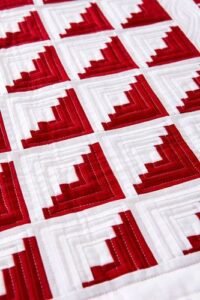
The History and Meaning of the Log Cabin Quilt Pattern
The Log Cabin quilt pattern has deep roots in American history, often associated with the pioneer era of the 19th century. The pattern symbolizes the idea of home and hearth, with the center square traditionally representing the hearth of the cabin, a source of warmth and stability.
The design became especially popular during the Civil War period, when women made quilts for soldiers and as a means of fundraising for war efforts. Each quilt carried symbolism and meaning, with dark and light fabric strips representing the balance of day and night, or life’s hardships and joys. As with many quilt patterns, these designs tell a story and reflect the values of the time.
Today, the Log Cabin quilt pattern continues to be popular not just because of its history but also because of its simplicity and versatility. Quilters of all skill levels enjoy experimenting with different fabric combinations and arrangements, making this pattern a timeless favorite.
Materials and Fabric Choices for a Log Cabin Quilt

Choosing the right fabric for your Log Cabin quilt pattern is a crucial step. The contrast between light and dark fabrics is a hallmark of this design, so you’ll want to select fabrics that offer a strong visual distinction. Traditionally, quilters used scraps of whatever fabrics they had available, but modern quilters have access to a wide variety of fabrics specifically designed for quilting.
Cotton fabrics are the most common choice for quilting due to their durability and ease of use. When selecting fabric, consider using solid colors, small prints, or even batiks to add depth and texture to your quilt. While traditional Log Cabin quilts often stick to neutral tones like beige, brown, and red, you can experiment with any color palette you prefer.
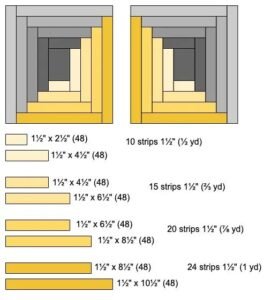
For the center square, many quilters opt for a red fabric to represent the warmth of the hearth, but feel free to get creative. Whether you choose to follow tradition or make your own interpretation, the fabric choices you make will give your Log Cabin quilt its unique character.
Step-by-Step Guide to Making a Log Cabin Quilt
Making a Log Cabin quilt pattern involves cutting fabric into strips and sewing them around a central square in a series of layers, or “logs.” Below is a step-by-step guide to help you create a classic Log Cabin block.
- Prepare Your Materials:
- You will need both light and dark fabrics for the strips, as well as a contrasting fabric for the center square. For a standard 12-inch finished block, cut the following pieces:
- 1 center square: 2.5″ x 2.5″
- 2 strips of light fabric: 2.5″ x 4.5″
- 2 strips of dark fabric: 2.5″ x 4.5″
- 2 strips of light fabric: 2.5″ x 6.5″
- 2 strips of dark fabric: 2.5″ x 6.5″
- 2 strips of light fabric: 2.5″ x 8.5″
- 2 strips of dark fabric: 2.5″ x 8.5″
- You will need both light and dark fabrics for the strips, as well as a contrasting fabric for the center square. For a standard 12-inch finished block, cut the following pieces:
- Assemble the Block:
- Start by placing the center square in the middle of your workspace. Sew the first light strip to one side of the center square, then sew the second light strip to the opposite side. Next, add the dark strips to the remaining sides of the center square.
- Continue Adding Layers:
- Continue adding layers of alternating light and dark fabric strips, sewing them to the edges of the block in a clockwise direction. Make sure each strip aligns perfectly with the previous one to maintain the crisp, square edges of the pattern.
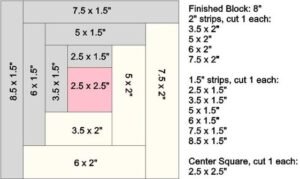
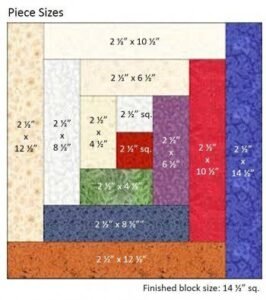
Quilting Techniques for Log Cabin Quilt Patterns
Once you’ve assembled all your Log Cabin blocks, it’s time to arrange them and piece them together into a quilt top. The arrangement of your blocks will determine the overall look of your quilt. Some popular layouts include straight furrows, barn raising, and fields and furrows. The layout you choose will create different visual effects and patterns across the quilt surface.
When piecing the blocks together, ensure that the seams between the blocks match up for a neat and professional finish. Pressing the seams properly as you go will help prevent bulk and make the quilting process smoother.
After assembling the quilt top, you can choose to quilt by hand or machine. Many quilters prefer to outline the Log Cabin design by stitching in the ditch, which involves sewing along the seams between the blocks. This technique emphasizes the block pattern and adds texture without distracting from the fabric design.

Tips for Personalizing Your Log Cabin Quilt
While the traditional Log Cabin quilt pattern is beloved for its simplicity, there are many ways to make it your own. One option is to play with the size of the blocks. You can create miniature Log Cabin blocks for a more intricate look or opt for oversized blocks for a modern twist.
Another way to personalize your quilt is through fabric choice. Mix and match prints, use unexpected colors, or even incorporate fabrics with sentimental value, like pieces of old clothing or linens. This gives your quilt a personal touch and turns it into a keepsake.
You can also experiment with the arrangement of the blocks. By rotating the blocks in different directions, you can create a variety of patterns and designs, each offering a different visual effect. The Log Cabin quilt pattern offers endless possibilities for creativity and self-expression.
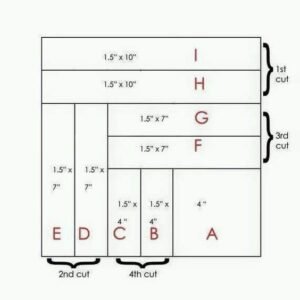
Quilting for Beginners: Why the Log Cabin Quilt Pattern is Ideal
The Log Cabin quilt pattern is an excellent choice for beginners because it is based on simple, straight-line sewing. It’s also a forgiving pattern, meaning that minor mistakes in cutting or sewing often blend into the overall design and aren’t noticeable. As long as you maintain a consistent seam allowance and press your seams carefully, your quilt will come together beautifully.
Additionally, the repetitive nature of the Log Cabin pattern allows beginners to practice important quilting skills, such as accurate cutting, piecing, and pressing. Once you’ve mastered the basics with this pattern, you’ll have the confidence to tackle more complex quilt patterns.

For experienced quilters, the Log Cabin quilt pattern is a canvas for creativity. You can play with color schemes, add embellishments, or experiment with different layouts to create a quilt that is uniquely yours.
The Lasting Appeal of the Log Cabin Quilt Pattern
The Log Cabin quilt pattern remains a beloved staple in the world of quilting, admired for its simplicity, versatility, and timeless appeal. Whether you’re a beginner looking for an accessible project or an experienced quilter eager to explore new variations, the Log Cabin pattern offers endless opportunities for creativity.
By following the step-by-step instructions and incorporating your personal touch through fabric selection and block arrangement, you can create a stunning quilt that reflects your style and skill.
Mini Log Cabin Coasters Free Pattern
Embrace the rich history and symbolic meaning of the Log Cabin pattern as you craft a quilt that will be treasured for years to come.


